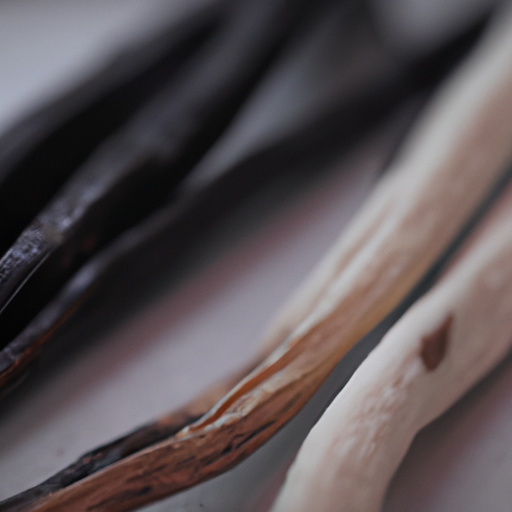Uncategorized
The Great Vanilla Debate: Natural vs Artificial
Exploring the Difference Between Natural and Artificial Vanilla Beans: A Comparison of High Vanillin Content
Vanilla beans are a popular flavoring ingredient used in many desserts and other culinary creations. While there are many different types of vanilla beans, the two most common are natural and artificial. While both types of beans can be used to impart a sweet, creamy flavor to dishes, there are some key differences between them.
This article will explore the differences between natural and artificial vanilla beans, with a particular focus on their vanillin content. Natural vanilla beans are derived from the seed pods of the vanilla orchid, a tropical plant native to Central and South America. The pods are harvested, cured, and dried to produce the vanilla beans that are used in cooking. Natural vanilla beans contain a compound called vanillin, which is responsible for the sweet, creamy flavor of the beans.
The vanillin content of natural vanilla beans can vary depending on the variety of bean and the growing conditions, but it is typically quite high. Artificial vanilla beans, on the other hand, are not derived from the vanilla orchid. Instead, they are created in a laboratory using a variety of chemicals and artificial flavorings. While artificial vanilla beans can be used to impart a sweet, creamy flavor to dishes, their vanillin content is typically much lower than that of natural vanilla beans.
This is because the artificial flavorings used to create the beans do not contain the same amount of vanillin as the natural beans. In conclusion, there are some key differences between natural and artificial vanilla beans. Natural vanilla beans contain a high amount of vanillin, while artificial vanilla beans contain a much lower amount.
While both types of beans can be used to impart a sweet, creamy flavor to dishes, natural vanilla beans are generally considered to be of higher quality and more flavorful than artificial beans.
The Pros and Cons of Natural Vanilla Beans vs Artificial Vanilla: Which is Better for Baking?

When it comes to baking, the debate between natural and artificial vanilla beans is a long-standing one. While both have their advantages and disadvantages, it is important to understand the differences between the two in order to make an informed decision about which is better for baking.
The primary advantage of natural vanilla beans is that they provide a more intense flavor than artificial vanilla. Natural vanilla beans are made from the cured seed pods of the vanilla orchid, which is native to Mexico and Central America. This gives them a unique flavor that is difficult to replicate with artificial ingredients. Additionally, natural vanilla beans are free from any artificial additives or preservatives, making them a healthier option for baking. On the other hand, artificial vanilla beans are much more affordable than natural ones.
They are also easier to find in stores, as they are widely available in most supermarkets. Artificial vanilla beans are also more consistent in flavor, as they are made from a blend of synthetic ingredients. This makes them a good choice for recipes that require a specific flavor profile. When it comes to baking, the choice between natural and artificial vanilla beans ultimately comes down to personal preference.
Natural vanilla beans provide a more intense flavor, while artificial vanilla beans are more affordable and easier to find. Ultimately, the best option for baking will depend on the recipe and the desired flavor profile.
Understanding the Flavor Profile of Natural Vanilla Beans vs Artificial Vanilla: What is the Difference?
Vanilla is one of the most popular flavors in the world, used in a variety of desserts, beverages, and other culinary creations. While many people are familiar with the taste of vanilla, few understand the difference between natural and artificial vanilla. This article will explain the flavor profile of natural and artificial vanilla beans, and how they differ.
Natural vanilla beans are derived from the seed pods of the vanilla orchid, a species of orchid native to Mexico. The flavor of natural vanilla is complex and nuanced, with notes of sweet, floral, and woody flavors. Natural vanilla is also known for its subtle smokiness and hints of spice. Natural vanilla is often described as having a creamy, buttery, and slightly smoky flavor.
Artificial vanilla, on the other hand, is made from a combination of synthetic chemicals and artificial flavors. Artificial vanilla has a much more one-dimensional flavor profile, with a strong, sweet, and slightly chemical taste. Artificial vanilla is often used in baked goods and other desserts, as it is much cheaper than natural vanilla.
The main difference between natural and artificial vanilla is the complexity of flavor. Natural vanilla has a much more complex flavor profile, with a variety of subtle notes and nuances. Artificial vanilla, on the other hand, has a much simpler flavor profile, with a strong, sweet, and slightly chemical taste. In conclusion, natural and artificial vanilla beans have different flavor profiles.
Natural vanilla has a complex flavor profile, with notes of sweet, floral, and woody flavors, while artificial vanilla has a much simpler flavor profile, with a strong, sweet, and slightly chemical taste. When choosing between natural and artificial vanilla, it is important to consider the flavor profile and the cost.

